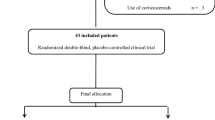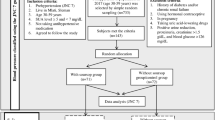Abstract
In this intervention study, we have investigated if hypertensive patients are more sensitive to liquorice-induced inhibition of 11 β-hydroxysteroid dehydrogenase (11 β-HSD) type 2 than normotensive (NT) subjects and if the response depends on gender. Healthy volunteers and patients with essential hypertension (HT), consumed 100 g of liquorice daily, for 4 weeks, corresponding to a daily intake of 150 mg glycyrrhetinic acid. Office, 24-h ambulatory blood pressure (BP) and blood samples were measured before, during and after liquorice consumption. Effect on cortisol metabolism was evaluated by determining the urinary total cortisol metabolites and urinary free cortisol/free cortisone quotient (Q). The mean rise in systolic BP with office measurements after 4 weeks of liquorice consumption was 3.5 mmHg (p<0.06) in NT and 15.3 mmHg (p=0.003) in hypertensive subjects, the response being different (p=0.004). The mean rise in diastolic BP was 3.6 mmHg (p=0.01) in NT and 9.3 mmHg (p<0.001) in hypertensive subjects, the response also being different (p=0.03). Liquorice induced more pronounced clinical symptoms in women than in men (p=0.0008), although the difference in the effect on the BP was not significant. The increase in Q was prominent (p<0.0001) and correlated to the rise in BP (p=0.02). The rise in BP was not dependant on age, the change in plasma renin activity or weight. We conclude that patients with essential HT are more sensitive to the inhibition of 11 β-HSD by liquorice than NT subjects, and that this inhibition causes more clinical symptoms in women than in men.
This is a preview of subscription content, access via your institution
Access options
Subscribe to this journal
Receive 12 digital issues and online access to articles
$119.00 per year
only $9.92 per issue
Buy this article
- Purchase on Springer Link
- Instant access to full article PDF
Prices may be subject to local taxes which are calculated during checkout


Similar content being viewed by others
References
van Uum SHM et al. The role of 11 beta-hydroxysteroid dehydrogenase in the pathogenesis of hypertension. Cardiovasc Res 1998; 38: 16–24.
Funder JW . Mineralocorticoids, glucocorticoids, receptors and response elements. Science 1993; 259 (February 19): 1132–1133.
Farese Jr RV et al. Licorice induced hypermineralcorticoidism. N Engl J Med 1991; 325: 1223–1227.
Albiston AL, Obeyesekere VR, Smith RE, Krozowski ZS . Cloning and tissue distribution of the human 11 beta-hydroxysteroid dehydrogenase type 2 enzyme. Mol Cell Endocrinol 1994; 105: R11–R17.
Monder C, White PC . 11 Beta-hydroxysteroid dehydrogenase. Vitam Horm 1993; 47: 187–271.
Brown RW, Chapman KE, Edwards CRW, Seckl JR . Human placental 11 beta-hydroxysteroid dehydrogenase. Evidence for and partial purification of a distinct NASD-dependent isoform. Endocrinology 1993; 132: 2614–2621.
Mercer WR, Krozowski SS . Localization of an 11 beta hydroxysteroid dehydrogenase activity to the distal nephron. Evidence for the existence of two species of dehydrogenase in the rat kidney. Endocrinology 1992; 130: 540–543.
Stewart PM, Murry BA, Mason I . Human kidney 11 beta-hydroxysteroid dehydrogenase is a high affinity nicotinamide adenine dinucleotide-dependent enzyme and differs from the cloned type 1 isoform. J Clin Endocr Metab 1994; 79: 480–484.
Walker BR, Campbell JC, Williams BC, Edwards CRW . Tissue-specific distribution of the NAD+-dependent isoform of 11 beta-hydroxysteroid dehydrogenase. Endocrinology 1992; 131: 970–972.
Ferrari P, Krozowski Z . Role of the 11 beta-hydroxysteroid dehydrogenase type 2 in blood pressure regulation. Kidney Int 2000; 57: 1374–1381.
Milford DV, Shackleton CHL, Stewart PM . Mineralocorticoid hypertension and congenital deficiency of 11 beta-hydroxysteroid dehydrogenase in a family with the syndrome of ‘apparent’ mineralocorticoid excess. Clin Endocrinology 1994; 43: 241–246.
Ulick S et al. A syndrome of apparent mineralocortocoid excess associated with defects in the peripheral metabolism of cortisol. J Clin Endocr Metab 1979; 49: 757–764.
Walker BR, Edwards CRW . Licorice-induced hypertension and syndromes of apparent mineralocorticoid excess. Endocrinol Metab Clin North Am 1994; 23: 359–377.
Epstein MT, Espiner EA, Donald RA, Hughes H . Liquorice toxicity and the renin–angiotensin–aldosterone axis in man. BMJ 1977; (January 22): 209–210.
Megia A, Herran L, Martin-Almendra MA, Martinez I . Angiotensin I-converting enzyme levels and renin–aldosterone axis recovery after cessation of chronic licorice ingestion. Nephron 1993; 65: 329–330.
Funder JW, Pierce PT, Smith R, Campell J . Vascular type I aldosterone binding sites are physiological mineralocortocoid receptors. Endocrinology (Baltimore) 1989; 125: 2224–2226.
Hatakeyama H, Satoru I, Miyamori I . 11 Beta-hydroxysteroid dehydrogenase in cultured human vascular cells. Possible role in the development of hypertension. Hypertension 1999; 33: 1179–1184.
Takeda Y et al. Gene expression of 11 beta-hydroxysteroid dehydrogenase in the mesenteric arteries of genetically hypertensive rats. Hypertension 1994; 23: 577–580.
Slight SH et al. High affinity NAD+-dependent 11 beta-hydroxysteroid dehydrogenase in the human heart. J Mol Cell Cardiol 1996; 28: 781–787.
Walker BR, Connacher AA, Webb DJ, Edwards CRW . Glucocorticoids and blood pressure: a role for the cortisol/cortisone shuttle in the control of vascular tone in man. Clin Sci 1992; 83: 171–178.
Walker BR et al. Increased vasoconstrictor sensitivity to glucocorticoids in essential hypertension. Hypertension 1996; 27: 190–196.
Walker BR et al. Deficient inactivation of cortisol by 11 beta-hydroxysteroid dehydrogenase in essential hypertension. Clin Endocrinol (oxf) 1993; 39: 221–227.
Soro A et al. Evidence of coexisting changes in 11 beta-hydroxysteroid dehydrogenase and 5 beta-reductase activity in subjects with untreated essential hypertension. Hypertension 1995; 25: 67–70.
Takeda Y et al. Endogenous renal 11 beta-hydroxysteroid dehydrogenase inhibitory factors in patients with low-renin essential hypertension. Hypertension 1996; 27: 197–201.
Walker BR et al. Endogenous inhibitors of 11-beta hydroxysteroid dehydrogenase in hypertension. J Clin Endocr Metab 1995; 80: 529–533.
Sigurjonsdottir HA, Franzson L, Manhem K, Ragnarsson J, Sigurdsson G, Wallerstedts . Liquorice-induced rise in blood pressure: a linear dose-response relationship. J Hum Hypertens 2001; 15: 549–552.
Shea S, Cook F, Kannel W, Golman L . Treatment of hypertension and its effect on cardiovascular risk factors: data from the Framingham Heart Study. Circulation 1985; 71: 22–30.
Axelson M, Sahlberg BL, Sjövall J . Analysis of profiles of conjugated steroids in urine by ion-exchange separation and gas chromatography-mass spectrometry. J Chromatogr 1981; 224: 355–370.
Mantel N . Chi-square tests with one degree of freedom; extensions of the Mantel–Haenszel procedure. J Am Statist Assoc 1963; 58: 690–700.
Bradley JW . Distribution-free Statistical Tests. Prentice-Hall: London, 1968.
Odén A, Wedel H . Arguments for Fisher's permutations test. Ann Statist 1975; 3: 518–520.
Kannel WB . Fifty years of Framingham Study contributions to understanding hypertension. J Hum Hypertens 2000; 14: 83–90.
Sigurjonsdottir HA, Ragnarsson J, Franzson L, Sigurdsson G . Is blood pressure commonly raised by moderate consumption of liquorice? J Hum Hypertens 1995; 9: 345–348.
Fuster D et al. Furosemide inhibits 11 beta-hydroxysteroid dehydrogenase type 2. Endocrinology 1998; 139: 3849–3854.
Escher G et al. Furosemide inhibits 11 beta-hydroxysteroid dehydrogenase in vitro and in vivo. Endocrinology 1995; 136: 1759–1765.
Valentino R et al. Alcohol inhibits 11-beta-hydroxysteroid dehydrogenase activity in rat kidney and liver. Horm Res 1995; 43: 176–180.
Blachley JD, Knochel JP . Tobacco chewer's hypokalemia: licorice revisited. N Engl J Med 1980; 302: 784–785.
Westman EC . Does smokeless tobacco cause hypertension. South Med J 1995; 88: 716–720.
Riddle MC, McDaniel PA . Renal 11 beta-hydroxysteroid dehydrogenase activity is enhanced by ramipril and captopril. J Clin Endocr Metab 1994; 78: 830–834.
Homma M et al. Activation of 11 beta-hydroxysteroid dehydrogenase by dehydroepiandrosterone sulphate as an anti-hypertensive agent in spontaneously hypertensive rats. J Pharm Pharmacol 1998; 50: 1139–1145.
Baulieu E-E . Dehydroepiandrosterone (DHEA): a fountain of youth? J Clin Endocr Metab 1996; 81: 3147–3151.
Acknowledgements
We thank the Malaco sweet factory in Sweden for kindly supplying all liquorice. This study was supported by a grant from The Göteborg Medical Society.
Author information
Authors and Affiliations
Corresponding author
Additional information
Competing interests
None declared.
Rights and permissions
About this article
Cite this article
Sigurjonsdottir, H., Manhem, K., Axelson, M. et al. Subjects with essential hypertension are more sensitive to the inhibition of 11 β-HSD by liquorice. J Hum Hypertens 17, 125–131 (2003). https://doi.org/10.1038/sj.jhh.1001504
Received:
Revised:
Accepted:
Published:
Issue Date:
DOI: https://doi.org/10.1038/sj.jhh.1001504
Keywords
This article is cited by
-
Food Products That May Cause an Increase in Blood Pressure
Current Hypertension Reports (2020)
-
The association between consistent licorice ingestion, hypertension and hypokalaemia: a systematic review and meta-analysis
Journal of Human Hypertension (2017)
-
Severe metabolic alkalosis, hypokalemia, and respiratory acidosis induced by the Chinese herbal medicine yokukansan in an elderly patient with muscle weakness and drowsiness
CEN Case Reports (2013)
-
11β-hydroxysteroid dehydrogenase type-2 and type-1 (11β-HSD2 and 11β-HSD1) and 5β-reductase activities in the pathogenia of essential hypertension
Endocrine (2010)
-
A hypertensive urgency induced by the continuous intake of a herbal remedy containing liquorice
Journal of Human Hypertension (2006)



